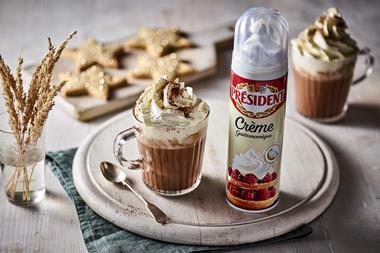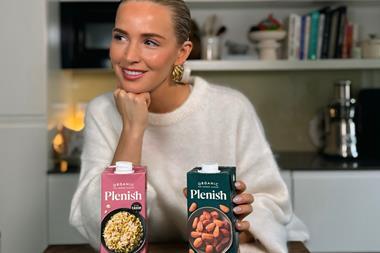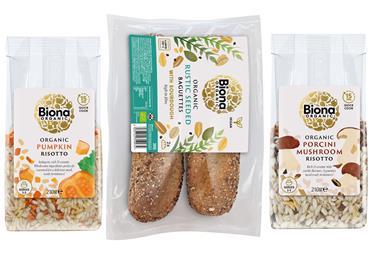Hot beverage sales are cooling and retailers have work to do to reheat the market. Aidan Fortune gets some tips on how to turn sales around.
Sit down and have a cuppa. That’s usually the first advice people are given when they’ve received some shocking news. So put the kettle on, as C-Store has to report that it’s not good news for tea and coffee in the hot beverages category. According to recent figures, tea sales are down by 8.5% compared with last year (Kantar 52 weeks ending March 31, 2012, independents and symbols).
It’s not that the brew is being usurped by any other hot drink - tea is still consumed by nine out of ten households - it’s more that it has been a victim of its own success, with pack-size promotions leading cash-strapped consumers to stockpile and buy less often.
Tetley GB customer marketing controller Simon Attfield says that consumers are looking to save money where they can and tea is one of the areas in which they seek out promotions. He acknowledges, however, this hasn’t been an entirely successful strategy for the category.
“Retailers have been driving the value message through promotions,” says Attfield. “Last year more than half of all tea bought was bought on promotion (54%) with consumers buying bigger packs for lower prices. Despite this activity, Nielsen is recording the tea market as being in decline.”
Attfield does believe that this can be turned around if retailers become a little braver about the category. “Understandably perhaps in the convenience sector, store owners look for the best deals in their cash and carry rather than focusing on increasing tea sales by considering what their customers really want and what would sell best,” he says. “The danger is that shelves become filled with secondary brands that are slow sellers and shoppers will be turned away when the top brands aren’t available. Tetley and PG Tips have the strongest loyalty and together account for more than 60% of branded tea sales.”
Tetley is hoping to build on this loyalty through a £10m marketing campaign which includes TV, radio, digital and social media activity. The brand is also revamping its packs to stand out on shelf better and attract more younger tea drinkers to Tetley.
Attfield also points out that retailers need to do more to make the tea aisle more interesting to shop. “Generally, shoppers don’t find the tea fixture engaging, often referring to it as the ‘quick aisle’, and there is little here to differentiate between retailers,” advises Attfield.
“There are simple things that retailers can do to the fixture to get shoppers excited. Shoppers love to interact with new products, but rather than hiding anything new away in a wall of boxes retailers should draw attention to it and make it stand out.”
He also believes retailers should take some notes from the wine aisle. “In the same way as a shopper will be nervous about buying a wine they have never tasted before, a new tea can be considered a risky buy, but to borrow a technique from the wine aisle, simple flavour notes describing the tea would do a lot to encourage purchase.”
Typhoo customer marketing manager Helen Cameron attributes the decline in tea sales to the growth in larger pack sizes in the convenience channel, although she believes it can be fixed by some ranging decisions.
“Tea prices are stable. However, the mix of pack sizes has altered,” she says. “Sizes are polarising with 40s and 240s in growth. While larger packs may offer value, they can lead to stock piling and affect the frequency of visit and overall footfall. Smaller, good value packs are the best to merchandise on convenience store fixtures and are perfect for customers wanting to manage their budget or do a top-up shop.”
Tana Walker, Unilever brand executive for PG Tips, says brands need to do their part to spice up the tea category and Unilever’s focus has been on creating occasions for consumers to enjoy tea.
“We are dedicated to continuing to support the tea category by attracting new consumers through value-added promotions and creating new and interesting products. We’ve placed emphasis on creating new consumption occasions for the category with the launch of The Special Moments range.
“We did this by emphasising the particular moment and occasion, as well as the related consumer benefits of the range,” adds Walker. “The launch has proven very successful, generating £3.3m incremental retail sales value for the category in the past 12 months. We have also seen new consumers coming to the category, attracted by these new varieties of black tea.”
Branch out
John Sutcliffe, convenience manager at Taylors of Harrogate, offers another strategy for retailers to follow. He is calling on retailers to be a bit bolder in their choice of teas stocked. “The majority of the fixture display should be taken by mainstream black tea - however, the key growth areas are in decaf, fruit and green teas. Therefore, retailers should apportion the right amount of space to this segment of the category,” he says.
Tom Hazelden, Partners for Growth controller and Unilever convenience manager, agrees that retailers should look beyond normal teas to more exotic blends.
“Tea is consumed by 90% of households, so it’s a key distress and top-up item in convenience stores,” says Hazelden. “However, tea tastes have evolved in recent years, with many people introducing fruit and herbal, speciality or green tea into their repertoire. A successful tea fixture should reflect these changes, with the best-selling lines faced proportional to store size and location.”
Hazelden doesn’t believe the staples should be overlooked, but rather that they are complemented with new flavours. “Normal tea represents 79% of sales, so focus on this area primarily, but with fruit and herbal teas now a mainstay of people’s repertoire you should also consider including this in your range if your shopper profile supports it,” he says. “These teas offer a growth opportunity as they are usually bought in addition to normal tea or coffee, rather than as an alternative.”
Cameron also believes that speciality teas are an area of potential. “The major multiple small format stores are ranging speciality and fruit & herbal teas where space allows,” she says. “And as people’s repertoires are expanding to include these variants, retailers should consider a mini range of these at affordable prices, which could help defend against the discounters and the small format multiples.”
He isn’t the only one advising retailers to expand their range. Attfield sees varying blends as a huge area of additional growth for the market, but realises it may take some time to get there.
“We still believe that this sector has huge potential, yet despite the excitement of last year, sales of rooibos teas have slowed showing a growth of only 3% in volume year on year,” he says. “Tetley Redbush 40s continue to be the best-selling rooibos tea in the market, a position it has held since five months post its launch in the summer of 1997. Sales of Tetley Redbush are up 4.5% in value year on year and it is still the market-leading brand (Nielsen Scantrack May 26, 2012).”
He believes retailers should be making customers aware of these newer products. “With a large variety of teas and brands, retailers need to do more to communicate the width of range to their shoppers. Often you see brand blocking used to the detriment of communicating the variety of range. An example is redbush teas which, despite being a relatively new sector of tea, are often found at the bottom of the tea fixture.”
Green tea is bucking market trends and showing some solid growth. Driven by the trend towards healthier living, consumption of green tea continues to grow, with volume sales up 12.1% in the market overall.
“Tetley has had an exciting year in green teas, which have seen the launch of Tetley Green Pure 100s in February,” says Attfield. “The new year is a key time for green teas and Tetley did exceptionally well this year with 189,000 new households buying Tetley and 113,000 of those new to green teas.”
Plunging sales
Unfortunately, the slide in sales isn’t confined to tea in the convenience channel. According to Kantar, the coffee category is down 9.3% year on year (Kantar 52 weeks ending March 31, 2012, independent and symbols).
Nestlé UK trade communications manager Graham Walker believes that more can be done by retailers to boost the category. “Consumers are often confronted with a confusing hot beverages fixture, particularly in the convenience channel, and the category is often hard to find in-store as shoppers perceive there to be low availability of stock. The soluble coffee range that is stocked is often inconsistent.”
He adds that there are some simple steps retailers can take to maximise the opportunity presented by hot beverage shoppers who are more likely to spend their money. “Place everyday coffee lower on the fixture, where you can give it more space, improving availability and reducing operating costs. This will also encourage shoppers to browse the fixture, trial new products and expand their repertoire.”
Walker urges retailers to ensure that they cover the full pricing spectrum to satisfy all customer types. “Ensure super-premium is visible and use pos to educate and inspire the shopper,” he says. “Place café-style coffee towards the middle of the fixture as this will encourage cross-shopping of segments and, remember, 100g jars of soluble coffee are the core packs for convenience.”
He also encourages retailers to concentrate on offering good value through promotions on leading brands such as Nescafé’s recent pricemarked packs of its Original 2-in-1 and 3-in-1 sachets. “As economic uncertainty and the rising inflation on food prices continue, shoppers are more aware of price than ever before,” adds Walker. “In fact, 73% of shoppers have said that promotions are a key factor when choosing between products in-store.
“With this is mind, it’s essential that retailers can help meet consumers’ needs by offering pricemarked packs on high-quality products. By launching our new five-sachet formats to convenience stores, we’re confident that we are offering consumers premium-tasting coffee at great value, as well as helping retailers grow their sales in a tough trading environment.”
Consumers’ desire to save money has also led to a new trend of barista-level instant coffee. Spoiled by coffee shops during the good times, shoppers are finding it tough to go back and are demanding higher-quality coffee that can be made at home quickly and cheaply. According to a recent Euromonitor International report, this trend is here to stay for the foreseeable future. Premiumisation is expected to continue to be seen in coffee as more consumers move away from basic instant coffee. The report predicts this trend will further evolve as consumers become increasingly aware of the benefits of coffee, but more importantly its origins and different flavours.
retailer’s view
Heather Stothard
“Tea promotions seem to be engaging my customers the most. They go out of their way to look for a promotion in an effort to save money. Once it’s a good brand name and there’s an offer involved, then they’ll buy it.
“When it comes to coffee, we stick to the 100g and 200g jars as they make up the majority of our coffee sales. It’s tricky because we have to keep coffee off the shop floor as it’s often targeted by shoplifters. People have to ask for it so fewer people buy it on impulse, but it also means that the customers who buy it once will always come back for it as they know we stock it, even though it’s not on display.”
Heather Stothard, Spar Maltby, Rotherham
Nescafé was quick to capitalise on this trend with the launch of Azera. “With the increasing consumer demand to drink coffee-shop quality at home, we are continually looking for ways to meet consumer needs as well as bring excitement to the category with new innovations,” says Walker. “By introducing the new Nescafé Azera, we are keen to provide retailers with a wider offering that delivers an instant barista-style coffee for in-home consumption.”
Kraft was also quick off the mark with its premium instant offering. It launched Kenco Millicano last year. “Kenco Millicano has seen huge success since its launch in 2011,” says Kraft’s Artur Kuczera. “More than two million households have bought Millicano and almost half the volume sales to date have been incremental to the total coffee market.”
To build on this success, Kraft has expanded the range to include a single-serve format. The packs contain 10 single-serve sticks of Kenco Millicano. According to Kuczera, the product has been designed to “suit busy shoppers looking for the smooth, full-bodied taste and rich aroma of Kenco Millicano in a convenient format.”
Milking it
One area of hot beverages that is showing growth in the convenience sector is the chocolate and hot milky drinks sub-categories. The market has shown a strong move towards more milk-based or traditional hot chocolates of late, with a 7.2% growth for the year ending May 19, 2012 within the impulse channel, giving the traditional market drivers of tea and coffee something to think about.
Manufacturers are focusing on growing the sub-category’s popularity to different age groups such as dieting women, and are introducing new products to consolidate its position.
Hot on choice
The category has seen new entrants over the past 12 months including Galaxy Traditional Hot Chocolate. According to Mars trade communications manager Bep Dhaliwal, retailers need to offer their shoppers some variety in hot beverages over the winter.
“With autumn and winter approaching it is the perfect opportunity to create a dedicated area to showcase hot chocolate, with particular emphasis on featuring the whole range,” she says. “Instant diet hot chocolate is also proving popular. In the four weeks to May 19, 2012 there was a 9.5% growth in this segment.”
Kraft trade communications manager Susan Nash agrees that this period is crucial for the sub-category, and that brands are investing more to take advantage. “Last winter, the hot chocolate and cocoa market grew by 4.7%, driven by one of the coldest November/December periods on record,” she says. “During this time, the Cadbury brand was supported with marketing activity including product sampling, advertising and a new pack design.”
To help attract more consumers to the sub-category, some brands have focused on value. Horlicks commercial director Denise Dewar says shoppers are looking for something more. “Consumers have become more value conscious,” says Dewar. “Value is not just price it can be an added benefit, or a favourite brand. By showing customers good value for money, retailers can drive purchasing both now and on repeat visits.”
To help drive this value for money message Horlicks has launched Traditional 300g + 50% extra-free packs as well as promotions such as extra-free packs to demonstrate good value and maintain loyalty with existing customers.
The brand is also adding products. “Horlicks launched the Horlicks Chocolate Cherry 500g SKU this February, which brought excitement into the category for both current and new consumers,” adds Dewar.
As winter is just around the corner now is the perfect time to shake up your hot beverages selection - and start hoping the British weather will provide some chilly temperatures and a little cold comfort for sales. ■
Pricemarked for success
To take advantage of consumers tightening their belts, manufacturers are increasing their focus on offering retailers pricemarked packs.
According to Nestlé UK trade communications manager Graham Walker, pricemarking reassures consumers that they are getting good value. “Price-marked packs allow the convenience retailer to offer a very attractive price point, which will be hugely motivating for the shopper,” he says.
Tetley customer marketing controller Simon Attfield acknowledges that shoppers are looking for value, and that price-marking is one of the best ways to provide this.
He says: “Remember, it is value and quality that customers are after, so look out for price-marked packs,” he advises. “This is a clear way at fixture to ensure the shopper knows they’re getting value.”
John Sutcliffe, convenience manager at Taylors of Harrogate, agrees that pricemarked packs are the perfect fit for the channel and has adjusted the brand’s range accordingly.
“Pricemarked packs work well within the convenience channel - we have now adopted this strategy across our core range and have recently added some new SKUs including Yorkshire Tea Decaf 80s.”
He adds: “We have seen significant year-on-year growth on all our pricemarked packs.”
Ones to watch
Orange appeal
Mars Chocolate Drinks & Treats has expanded its hot chocolate range with the launch of Galaxy Bubbles Orange. Containing only 40 calories, the new variant comes in a 200g re-sealable pack.
rrp: £2.99
tel: 01942 272900
Perfect combo
Nestlé has introduced new Nescafé sachet formats specifically for convenience stores. Available in £1 price-marked packs, Nescafé 3-in-1 and 2-in-1 sachets aim to attract younger consumers to the soluble coffee category.
tel: 0800 585759
Art gallery
Two new variants join Drury Tea and Coffee Company’s portfolio: British breakfast (rrp £2.65) and white tea with rose & pomegranate (£3.75). The teas are available in boxes of 15 bags. Both blends carry Drury art deco pack designs.
tel: 020 7740 1100
In the pink
Tetley has added a new blend that combines green tea with everyday black tea. Blend of Both is now available in an 80-pack, featuring distinctive pink packaging to help it stand out on shelf.
tel: 020 8338 4367
rrp: £2.55
Colour coded
Percol has revamped the packaging on its ground coffee range to celebrate its 25th birthday. The packaging features a different colour for each blend and includes more information on the coffee’s strength and country of origin.
tel: 020 7978 5300




























No comments yet